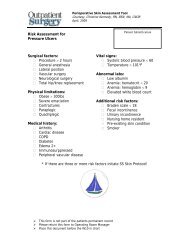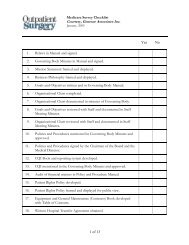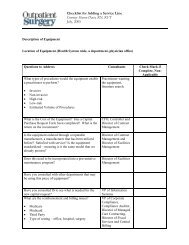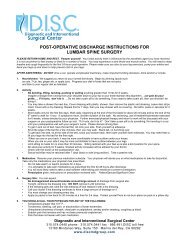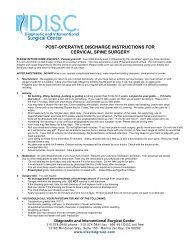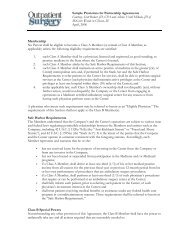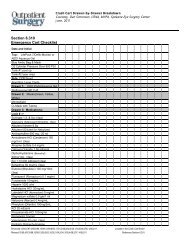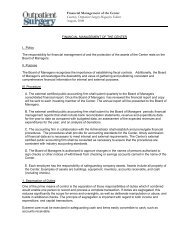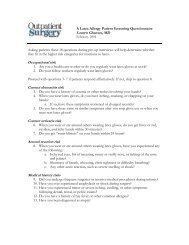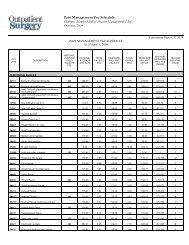Patient-Controlled Analgesia (PCA) - Outpatient Surgery Magazine
Patient-Controlled Analgesia (PCA) - Outpatient Surgery Magazine
Patient-Controlled Analgesia (PCA) - Outpatient Surgery Magazine
Create successful ePaper yourself
Turn your PDF publications into a flip-book with our unique Google optimized e-Paper software.
Suggested <strong>Patient</strong> <strong>Controlled</strong> <strong>Analgesia</strong> (<strong>PCA</strong>) SafetyProtocolCourtesy, Institute for Safe Medication PracticesMay, 20047. Require a pharmacist to review all <strong>PCA</strong> orders before initiation (exception:when a pharmacist is not on site) and suggest dose adjustments or an alternativeopiate when appropriate.8. Use "tall man" lettering on pharmacy-applied labels for HYDROmorphone tohelp avoid confusion with morphine.9. Alert clinicians to potential drug shortages with <strong>PCA</strong> opiates and, if encountered,recommend an alternative drug with clear dosing instructions.When initiating <strong>PCA</strong>1. Check patient allergies, which should be visible on the medication administrationrecord (MAR), before initiating <strong>PCA</strong>.2. Connect <strong>PCA</strong> to a port close to the patient (to avoid dead space) and prominentlylabel the infusion line at this connection to avoid mix-ups with other lines.3. Provide laminated instructions for programming <strong>PCA</strong> pumps for reference bynurses who may infrequently initiate <strong>PCA</strong>.4. Require two clinicians to independently double-check the patient's identification,drug and concentration, <strong>PCA</strong> pump settings, and the line attachment before use(and before pump refill or programming change). <strong>Patient</strong>side bar-coding can beused to verify the patient and drug/concentration; however, pump settings maystill require an independent double check.5. Avoid nurse-controlled <strong>PCA</strong> unless special monitoring is in place.6. Verify <strong>PCA</strong> settings each shift, immediately after receiving report.7. Avoid administering concomitant opiates (an alert should appear on the MAR).8. Have oxygen and naloxone readily available when initiating the device.9. Educate patients about the proper use of <strong>PCA</strong> before initiation. Start during thepreoperative testing visit so patients are not too groggy to understand. Warnfamily members and visitors about the danger of <strong>PCA</strong>-by-proxy.When monitoring the effects of <strong>PCA</strong>1. Establish a standard measurement scale to assess the patient's level of pain.2. Develop monitoring requirements for patients who are receiving <strong>PCA</strong> and bealert for signs of oversedation. At a minimum, evaluate the patient's level of pain,alertness, and vital signs, including rate and quality of respirations, every 4 hours.3. Evaluate all patients with minimal verbal and tactile stimulation to obtain anaccurate assessment of their level of sedation.4. Monitor patients more frequently during the first 24 hours and at night, whenhypoventilation and nocturnal hypoxia may occur.





